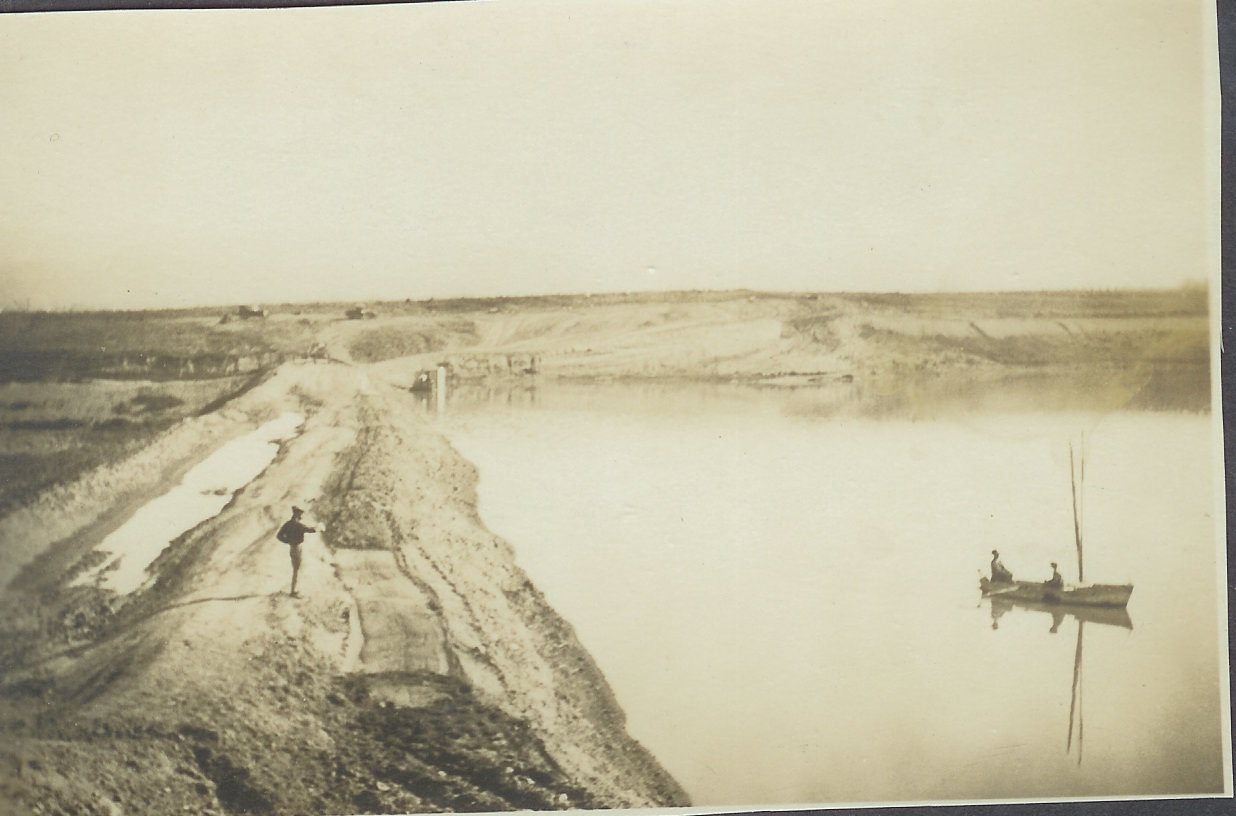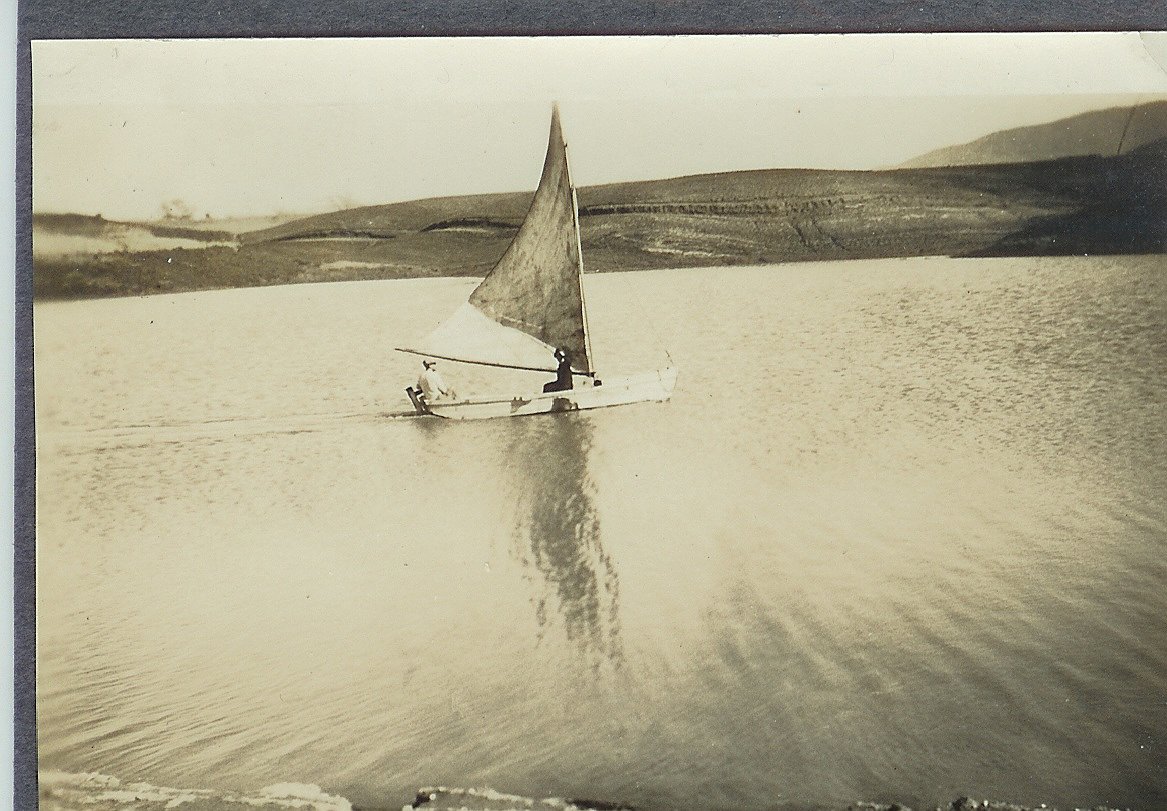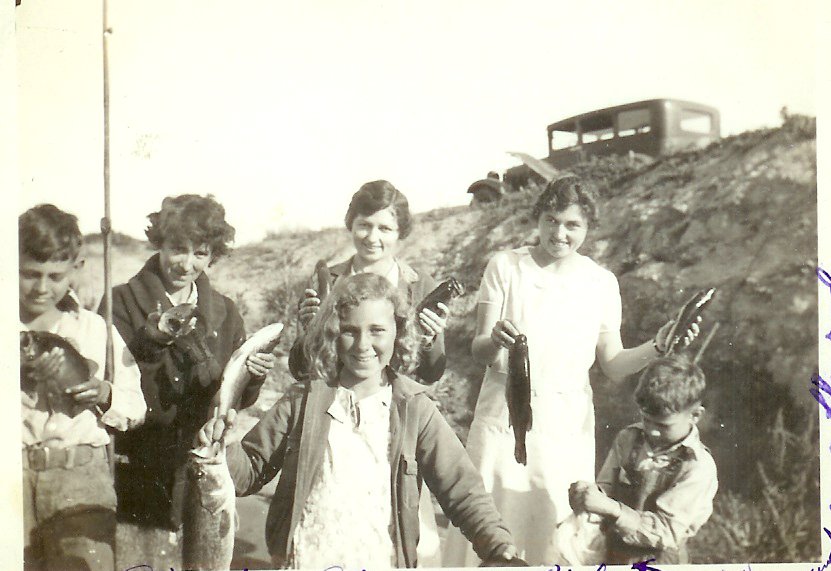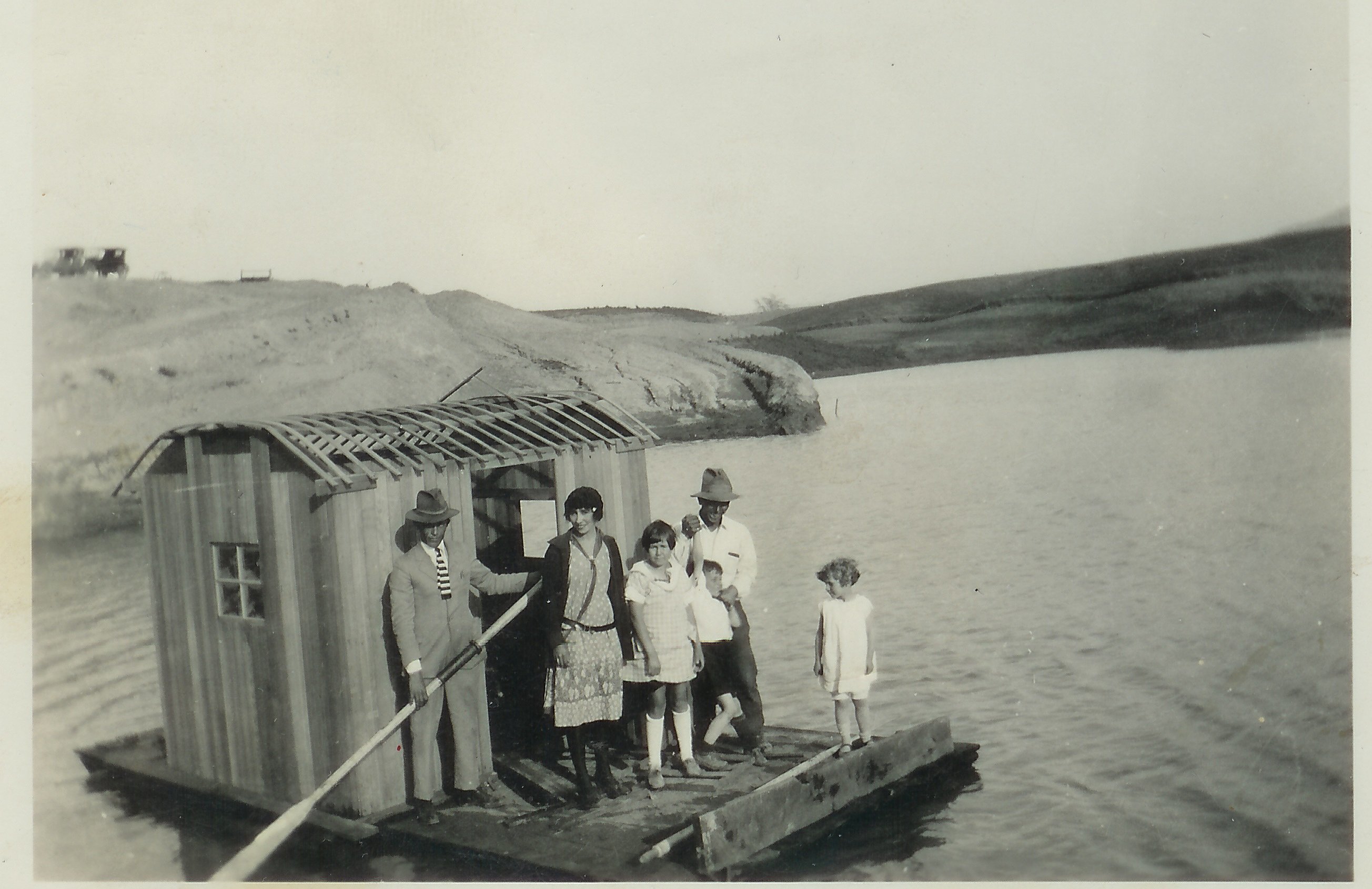History of Sinaloa Lake 8-18-02
My maternal Grandfather, C.E. Utt, purchased 512 aces from Bank of Italy (later Bank of America) in 1922 or 23. My father, Thomas A. Robertson and his father, Luis Robertson invested in the property. Title passed to Hacienda Sinaloa Inc. in 1926. Ownership was Thomas Robertson 50% Luis Robertson 25%C.E. Utt 25%Construction of the dam began in 1925. Mule drawn "breaking" plows loosened the soil, mainly on the knoll at the south end of the dam. Four-mule Fresno scrapers were used to move the dirt into place. The compaction was entirely from the hooves of the mules. The fill area was flooded with water as needed for better compaction. You can see a smaller two-mule (or horse), Fresno scraper at the Strathearn Historical Park. The work took several years to complete, as the mules were needed for the farming enterprise as well. I was born in 1923, and I can remember going with my father to watch the activity when I was surely five or six years old.

The enclosed photo, south to north, shows the lake already formed while there
is much work yet to be done on the dam. Tom Robertson is standing on the dam,
with C.E. Utt in the back of the boat and Luis Robertson at the oars. The smooth
area just in front of my father is the "haul road" made by the loaded
scrapers. Beyond the smooth area is a series of dumps. When the dumps are complete
from end to end they will be smoothed with a few passes of the scrapers in the
spread position, then the process started over again. I would estimate that
the completed dam would be at least ten feet higher than what is seen in the
Photo.A small diversion dam was built at the south end of the ranch in the canyon
where the present day Flood Control dam is situated. Runoff from the ranches
to the south was diverted into a ditch that fed into the lake. The purpose of
the lake was to store rainwater for irrigation in the summer. Recreational use
was a fringe benefit. In good rain years the lake filled with water. In the
dry years we pumped well water into the lake in the late winter and early spring.
In those days electricity for that purpose was very cheap in the winter months.
We could irrigate 100 acres or more by gravity from the lake. About that much
more was irrigated by using a booster pump, located at the south end of the
dam.

Luis Robertsonís sail boat, the first of many!
The completed dam had a large outlet valve at the north end of the dam, for irrigation. The lower of two overflow spillways was adjacent to the intake ditch. The other slightly higher spillway was at the north end of the dam. My guess is that the higher spillway was no more than two feet below the top of the dam. This entire project was completed without benefit of engineers, permits, or advice, (spell that interference), from any bureaucracy. Later, about 1930 C.E. Utt gave his share of the ranch to my mother, Dorothy Robertson. The Corporation was dissolved and a partnership formed under the name Sinaloa Ranch.

A very good fishing day, including the largest bass caught in Sinaloa Lake
up to that time, about 1931. Back row; Alan Robertson, Dorothy Robertson Margaret
and Jane Cannell. Front row; Jean and Leigh Robertson, and fish!
In the late forties or early fifties the CA Dept. of something or other decided that they had jurisdiction of the dam. They made us cut the spillways about eight or ten feet lower. They also wanted a new shutoff valve installed on the upstream end of the outlet pipe. The lake was nearly entirely drained for this job. Sadly, that was not the last time that the heavy hand of bureaucracy came down on Sinaloa Lake!I set down this brief history of the construction of the lake at the request of some of the present day owners. It occurs to me that some of you may be interested in the more recent history.The lake served itís purpose as a reservoir for irrigation water for many years. During the years that I handled the irrigation of the ranch I pumped water into the lake, pumped water out, and irrigated by gravity. I recall one very heavy rainstorm when Alan and I walked over to see how much water was in the lake. When we arrived, the water level was already quite high. I remember putting a marker of some kind at the waterís edge at the north end of the dam. We then walked across the dam to look at the intake ditch, which was running bank to bank. Surely no more than an hour passed before we checked our marker again. The water level had risen a foot in that time! I vaguely remember that we had sandbagged both overflows, in order to store more water. It was obvious that water would be going over the sandbags before long. I opened the outlet valve that fed into a 16-inch concrete pipe. This pipe in turn fed into several 8-inch laterals for irrigating the low ground east of Madera (Kujawski) Road. These lines could be opened to flow into the drainage ditch next to that road. With those lines running at capacity, and both overflows running, the water finally stopped rising about one foot below the top of the dam.

Floating Dock and Bathhouse
I know that there was another year that the intake ditch was deliberately breached in the area that it was above ground level. This allowed the water to flow out into a walnut orchard; to spread out over the lowland mentioned above. Probably the most serious threat to the dam came in the late forties. I mentioned that there was a booster pump at the south end of the dam. A six or seven inch steel pipe through the dam, just above ground level, fed it. This pipe rusted away in the middle of the dam, washing the earth away on the outside of the dam. There was no shutoff valve in the lake, or it was inoperative, so there was no way to shut the water off. Alan got a deep-sea diver to come in and drive a tapered wooden plug into the upstream end of the pipe. I guess thatís what you could call a successful marriage of very old and very new technology! Once the flow of water was stopped, the pipe was repaired and then the dam repaired. The lake had lots of water in it at the time. The washout was nearly half the width of the dam, but the dam did not fail. I would say that was testimony to the fact that the dam-builders had done a good job!

We kept two canoes in this floating boat house
In the mid-fifties Alan Robertson started subdividing all the land on what we called Long Mesa. Eventually he subdivided all the land that we still owned around the lake. As a sales incentive he gave lake privileges to all the lots that bordered on the lake. As time went by we were farming less and less, and we found ourselves maintaining the lake and keeping water in it to keep the homeowners happy. The solution was to deed the lake and the road around it to the newly formed Lakeowners Assoc. All parties signed the necessary documents, and then Alan took the papers to San Miguel for Tom and Dorothy Robertson to sign. Tom insisted on adding a clause that stated that the lake must be used only for non-commercial purposes, and that it must remain a lake. If these conditions were not met, the property would revert back to the Robertson Family. This change was in the form of an amendment to the Deed. All the Robertson children were given the opportunity to become dues-paying members of the Lakeowners. My brother Tom was the only one that became a member.The Lakeowners eventually bought a well near the town of Simi, and ran a pipeline all the way to the lake to keep the water level up.All went well until about 1984. Iím not sure how it happened, but a small portion of the outside of the dam sloughed off. This could have been caused by a gopher hole, or by a break in a two-inch pipe buried in the top of the dam. We were living in Mariposa by this time, so I only know what I was told and saw in pictures. I am absolutely certain that the dam was in no danger of collapsing. The washout forty years earlier was much, much more severe, and the dam held. Unfortunately, the "Chicken Little" effect took hold. Some government agency declared that the sky was falling, and soon the Simi City Council, the Ventura County Flood Control District, one or two State Agencies and the US Corps of Engineers were on the scene, each one more alarmed than the next. They evacuated a bunch of homes downstream. They brought in a number of large pumps to lower the water level, and I believe that they took ten feet or so off the top of a portion of the dam to keep the water level low in case of rain. I think it was on a Friday that the decision was made to breach the dam down to ground level. The Lakeowners started the process of getting an injunction to stop this action, but were not able to get into court until Monday. Over the weekend the engineers moved in and did the deed. No need to get the courts involved, after all, we know whatís best!I should mention that I had taken over the ranch affairs about fifteen years before this time, when Alan moved to Paso Robles. Also, both of my parents had passed away and I had liquidated Dorothyís estate. Tom had no estate in the US by the time he passed. The first news I had of the lake problem was a phone call from Jane Seaman. Some of the directors of the Lakeowners wanted to fly to Mariposa to talk to me about the Reversion Clause. To tell the truth, I had forgotten all about it. I called Alan, and he filled me in on how it came about. What the Lakeowners wanted was to rebuild the dam, but before starting that process they wanted to know where we stood. They hoped to be able to buy out our interest. I assured them that I would work with them on this, but I needed to consult the family, and my attorney. We set up a meeting in Simi. I got hold of a copy of the deed and the amendment thereto. Meanwhile, I talked to other family members, and we all agreed that we did not want to make any effort to reclaim the property. The local paper got wind of the Reversion Clause and printed an article about how much the wealthy Robertson family might prosper from taking back the land and building condominiums. I thought it was quite hilarious! I showed the Deed and amendment to my attorney. He read it over and looked very puzzled. He said that he had been doing this sort of work for many years and had never seen an amendment to a deed. The two documents were not even recorded at the same time. He doubted the validity of the amendment, and said he would not look forward to trying to enforce it. I kept this bit of information to myself, but I suspect that the Lakeowners had surely gotten the same advice from their attorney. I finally struck a deal with them for enough money to give each family $5000. It was like found money. The Lakeowners got a high powered attorney to file a suit against the State of CA and the Corps of Engineers. They lost the suit against the state, and failed to file the federal suit before the Statute of Limitations ran out. All of this took several years. Next the Lakeowners got an even higher-powered attorney to sue the first attorney for malpractice. This case was settled out of court for a considerable sum. They used that money to rebuild the dam. It took more years to get all the permits required, but the new, much lower dam started impounding water in the year 2000, I believe. It had been a mighty struggle, but Iím glad that they finally prevailed. It appears that what my father and grandfathers envisioned and created so long ago will remain as a monument to that vision for many years to come. Allís well that ends well!